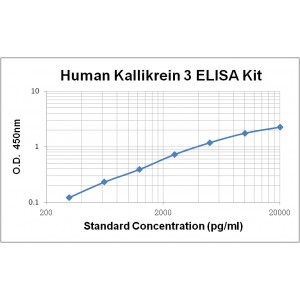More info
Assay Range | 312 -20,000 pg/mL |
Sensitivity | 10.0 pg/mL |
Size | 96T |
Storage | Store at 2 - 8ºC. Keep reconstituted standard and detection Ab at -20 ºC |
Assay Principle | Sandwich ELISA |
Sample Volume | 100 µL final volume, dilution factor varies on samples |
Detection Method | Chromogenic |
Kit Components
1. Recombinant Human Kallikrein 3 standard: 2 vials
2. One 96-well plate coated with Human Kallikrein 3 Ab
3. Sample diluent buffer: 12 mL - 1
4. Detection antibody: 130 µL, dilution 1:100
5. Streptavidin-HRP: 130 µL, dilution 1:100
6. Antibody diluent buffer: 12 mL x1
7. Streptavidin-HRP diluent buffer: 12 mL x1
8. TMB developing agent: 10 mL x1
9. Stop solution: 10 mL x1
10. Washing solution (20x): 25 mL x1
Background
Human tissue Kallikrein 3 (KLK3), also known as prostate specific antigen (PSA), is a serine protease of the human tissue kallikrein family. KLK3 is secreted by the epithelial cells of the prostate gland as an inactive enzyme (proPSA) which is composed of 244 amino acids and can be converted into the active form after removal of 7 amino acids from the N-terminus. As a serine protease, the primary role of KLK3 is to cleave the gel-forming proteins in semen, seminogelin I, and seminogelin II, leading to liquefaction of semen clogs after ejaculation.
The expression of KLK3 is regulated by androgen. KLK3 can thus be used as a biomarker to monitor the integrity of the androgen receptor signaling pathway. Normally, KLK3 exists in small amounts in the serum of men. About 70-90% of the KLK3 circulating in serum complexes with α1-anti-chymotrypsin (ACT)/serpin A3, The remaining 10-30% exists as unbound inactive enzyme (free KLK3). If prostatic tissue damage occurs, such as in prostate cancer and benign hyperplasia, excess amounts of KLK3 will leak into the circulation, resulting in increased serum total KLK3 (ACT-bound and free KLK3) levels. Elevated levels of KLK3 have been found in prostate cancer or other prostate disorders.


